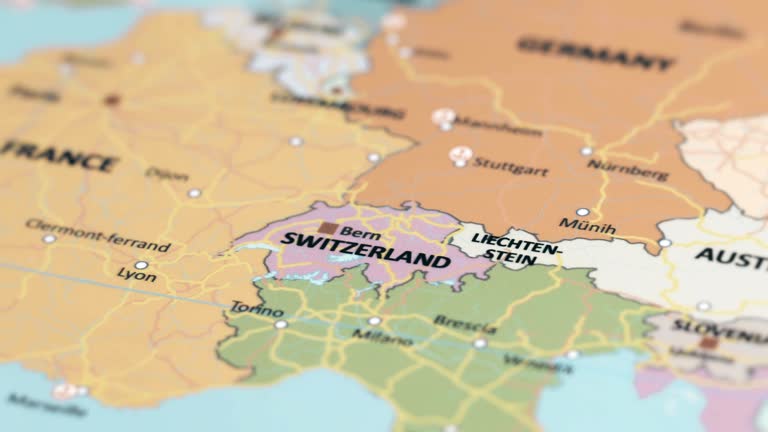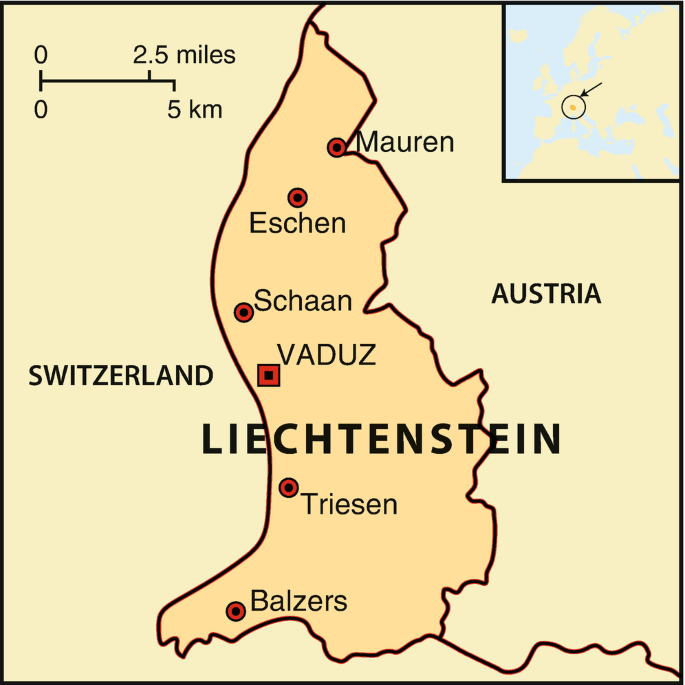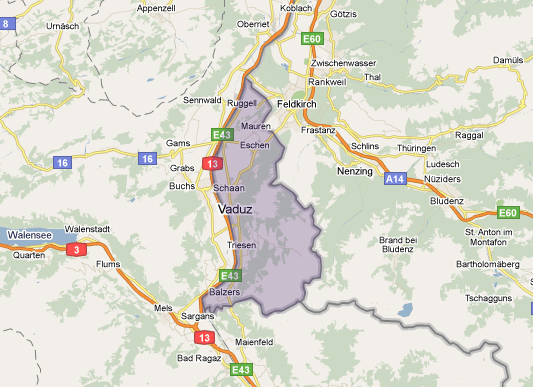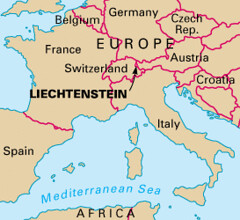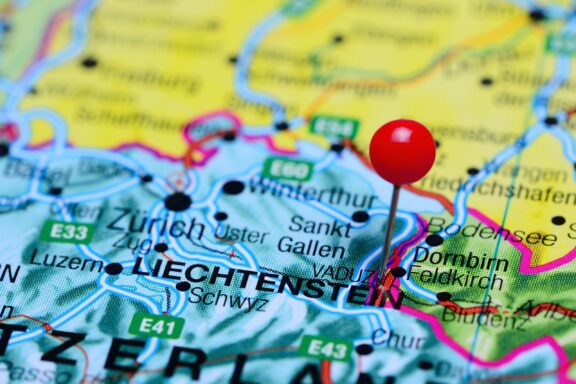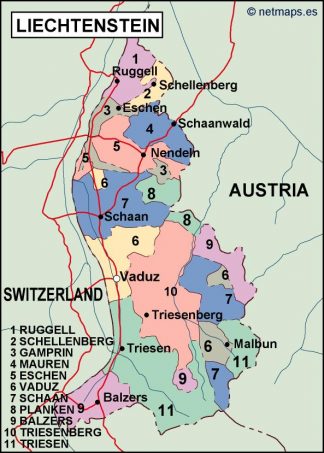Map Of Liechtenstein - Regions, Cities, Royal Family & Must-See Sights
A map of Liechtenstein opens up a world of possibilities. From its well-connected cities to its dramatic alpine landscapes, this guide will show you how to navigate the country.
Author:Finn WildeReviewer:Michael RachalDec 08, 202412.8K Shares273.5K Views
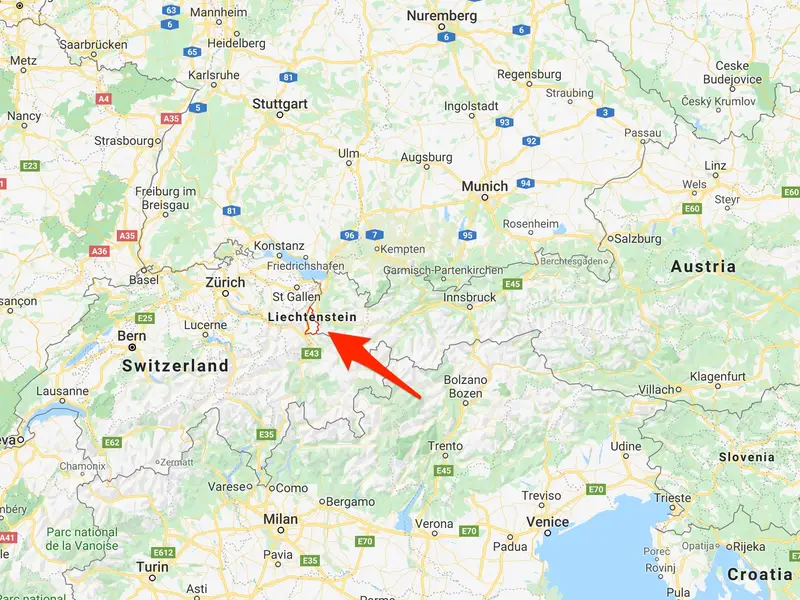
Liechtenstein may be one of the smallest countries in the world, but its geographical and cultural significance is anything but minor. Nestled between Austria and Switzerland, this charming principality boasts a landscape rich in natural beauty, historic cities, and unique landmarks.
Understanding the map of Liechtensteinnot only helps in planning a visit but also unveils the hidden gems of a country with much more than meets the eye. From scenic mountain ranges to cultural sites, navigating this tiny yet fascinating country is an experience all on its own.
Quick Facts
- Area:160 square kilometers (61.8 square miles)
- Capital:Vaduz
- Borders:Switzerland to the west and Austria to the east
- Major River:The Rhine River
Geographical Overview Of Liechtenstein
Liechtenstein is a small, landlocked country located in Central Europe. It lies between Switzerland to the west and Austria to the east, bordered by the Rhine River to the north. Despite its compact size, the country is surrounded by majestic mountain ranges, specifically the Alps, offering breathtaking views and numerous outdoor activities.
For travelers seeking cheapest places to travel in Europe, Liechtenstein offers incredible value with its mix of stunning landscapes and accessible attractions without the overwhelming crowds found in larger European destinations.
Capital Of Liechtenstein
The capital city of Liechtenstein is Vaduz, located along the banks of the Rhine River. Vaduz serves as the political and cultural center of the country. Despite its small size, the city is home to several important landmarks, including the Vaduz Castle, the Kunstmuseum, and the Liechtenstein National Museum.
The castle, perched high on a hill, serves as the residence of the princely family and offers a glimpse into the country's royal history. Vaduz, with its rich history and stunning landscapes, is undoubtedly one of the best places in Europeto experience a unique blend of culture and natural beauty.
Map Of Liechtenstein Cities
1. Vaduz
Vaduz is the capital city and political center of Liechtenstein. Located along the banks of the Rhine River, Vaduz is known for its Vaduz Castle, which serves as the residence of the royal family. The city is a cultural hub, with several museums like the Kunstmuseum Liechtenstein and the Liechtenstein National Museum. Vaduz is also home to various government institutions and financial institutions, making it a key player in the country’s economic landscape.
2. Schaan
Schaan is the largest city in Liechtenstein and serves as the country's economic heart. Located just north of Vaduz, Schaan is an important industrial and commercial center, hosting a variety of international businesses. The city is also known for its high standard of living, modern infrastructure, and beautiful parks. Schaan’s proximity to Vaduz makes it an ideal location for both work and residential life.
3. Balzers
Balzers is a picturesque town located near the Swiss border in the southern part of Liechtenstein. Known for its rich history, Balzers features the Balzers Castle, an important historical landmark. The town is situated at the foot of the Liechtenstein Alps and offers scenic views of the surrounding landscape. Balzers is also known for its peaceful environment and close-knit community, making it a lovely place to visit or live.
4. Eschen
Eschen is located in the western part of Liechtenstein, near the Austrian border. The town is surrounded by lush greenery and is often considered one of the more rural municipalities. Eschen is known for its beautiful landscapes, including hiking and biking trails that attract nature lovers. The town is also home to a few small businesses and a vibrant community that hosts various cultural events throughout the year.
5. Mauren
Mauren is the northernmost municipality in Liechtenstein, located near the Swiss border. It is known for its agricultural activities and serene environment. The town has a rich local culture and hosts various community events. Mauren is also home to St. Peter and Paul Church, a beautiful baroque-style church that adds to the town’s historical charm. The peaceful atmosphere makes it an attractive place for both residents and visitors.
6. Nendeln
Nendeln is located in the central part of Liechtenstein, within close proximity to the capital, Vaduz. Nendeln is a quieter town, known for its agricultural fields and historic buildings. It is home to the Schloss Nendeln, a historic site that tells the story of the town’s past. Nendeln is also famous for the Liechtenstein Museum of Fine Arts, which hosts exhibitions showcasing both local and international artists.
7. Ruggell
Ruggell is located on the northernmost tip of Liechtenstein, along the Rhine River. Known for its agriculture and green spaces, Ruggell offers a more rural and tranquil lifestyle compared to the more urbanized cities like Vaduz and Schaan. The town is close to the Swiss border and offers excellent opportunities for outdoor activities like hiking and cycling. Ruggell is also home to the Ruggell Nature Reserve, which is an important area for birdwatching and biodiversity.
8. Schellenberg
Schellenberg is a small but charming village located in the eastern part of Liechtenstein. It is known for its traditional architecture, with many houses showcasing the country’s cultural heritage. The town also has a rich history, with the Schellenberg Castle being one of its major historical landmarks. The village is a peaceful and scenic place, surrounded by vineyards and farmland, providing an ideal spot for relaxation and exploration.
9. Bendern
Bendern is located near the center of Liechtenstein and is known for its historical significance and cultural heritage. The town has a number of old buildings and landmarks, including the St. Nicholas Chapel, which is a local place of worship. Bendern is also recognized for its connection to local crafts and artisanal products, with various workshops and small businesses located in the area.
10. Planken
Planken is a small village in the southern part of Liechtenstein, situated in the mountainous region. It is known for its beautiful views of the surrounding Alps and its outdoor recreational activities. The town is a haven for nature lovers, offering various trails for hiking and skiing in the winter. Despite its small size, Planken has a welcoming community and a peaceful environment, making it a perfect destination for relaxation.
11. Triesen
Triesen is located just south of Schaan and is known for its historical significance and natural beauty. The town is home to the Triesenberg, a mountain offering spectacular views of the country and surrounding areas. The area has a blend of old and new, with charming historic buildings alongside modern homes and facilities. Triesen is a popular destination for tourists looking to explore the countryside and enjoy outdoor activities.
Regions On The Map Of Liechtenstein
Liechtenstein is divided into several distinct regions, each with its own characteristics. The 11 municipalities are spread across two primary regions: the Rhein Valley (on the north) and the Alpine region (on the south).
- Rhein Valley:This is the more urbanized region of Liechtenstein, featuring key cities like Vaduz and Schaan, and serving as the economic and administrative core of the country.
- Alpine Region:The southern part of Liechtenstein is dominated by mountainous terrain, with the Alps providing a dramatic backdrop to the country’s natural beauty.
The country’s compact size means these regions are easily accessible, and maps of Liechtenstein often show these key distinctions to help tourists plan their trips accordingly.
Population Of Liechtenstein
Liechtenstein has a relatively small population, with just around 39,000 residents. Despite its small size, it’s known for having a high standard of living. The population is predominantly ethnic German, and the official language is German, although many residents also speak English and other languages, particularly in urban areas.
The country’s population density is one of the highest in Europe, and it’s home to a mix of local Liechtensteiners and foreign nationals, particularly those from neighboring countries such as Switzerland and Austria.
Currency Of Liechtenstein
The currency used in Liechtenstein is the Swiss Franc (CHF). Despite being a sovereign nation, Liechtenstein has close economic ties with Switzerland, and the Swiss Franc is the preferred currency for daily transactions. The use of the Swiss Franc, rather than the Euro, makes Liechtenstein unique among many of its European neighbors.
Dialing Code Of Liechtenstein
Liechtenstein shares the international dialing code +423, which is used to connect the country with the rest of the world. This code is often required when making phone calls to or from Liechtenstein, whether for business, tourism, or communication with residents.
Language Of Liechtenstein
The official language of Liechtenstein is German, and the Liechtenstein dialect is a variation of the Alemannic dialect, which is spoken in parts of Switzerland and Austria. In addition to German, many residents also speak English, French, and Italian, especially in the urban areas and for business purposes.
Flag Of Liechtenstein
The flag of Liechtenstein features two horizontal bands of blue and red with a gold crown in the upper left corner. The blue symbolizes the sky and the red represents the country’s strength. The crown symbolizes the royal family of Liechtenstein, reflecting the country’s status as a constitutional monarchy.
Government Of Liechtenstein
Liechtenstein is a constitutional monarchy, with the Prince of Liechtenstein serving as the head of state. The country also has a parliamentary system that governs with the help of elected representatives. The Prince holds significant influence but is also bound by the Constitution of Liechtenstein, which ensures that the country’s governance is democratic and fair.
The political system of Liechtenstein blends the traditions of monarchy with modern democratic processes, making it a unique example of governance in Europe.
Total Area Of Liechtenstein
Liechtenstein is one of the smallest countries in the world, with a total land area of just 160 square kilometers (61.8 square miles). Despite its small size, it has a population density much higher than the European average. Its compact size makes it one of the most efficient countries to navigate, allowing visitors to explore it in just a few days.
Types Of Liechtenstein Maps
- Topographical Maps: These maps show the detailed landscape of the country, including mountains, valleys, rivers, and man-made features.
- Political Maps: These maps focus on the administrative divisions of the country, highlighting cities, towns, and municipalities.
- Tourist Maps: These maps are designed for visitors, showcasing popular attractions, hiking routes, museums, and historical landmarks.
- Interactive Maps: With the rise of digital technology, many visitors now use online maps or mobile apps for navigation, which offer interactive features for real-time travelguidance.
Liechtenstein’s Borders And Neighboring Countries
Liechtenstein shares its borders with Austria to the east and Switzerland to the west. The Rhine River forms the natural northern boundary, providing a scenic and navigable route. Liechtenstein’s strategic location between these two countries makes it a prime spot for cross-border commerce and cultural exchange.
National Parks And Landscapes
1. Rheinwald
Rheinwald is one of Liechtenstein's most important natural landscapes, primarily known for its river basin and the Rhine River, which forms the northern border of the country. The landscape in this region is characterized by steep, rugged mountains, deep gorges, and rich vegetation. The area provides excellent opportunities for hiking, fishing, and birdwatching, especially along the riverbanks. The Rheinwald is vital for local biodiversity, and several hiking routes follow the course of the river, allowing visitors to appreciate the natural beauty of the environment.
2. Alpenpark Liechtenstein
Located on the southern slopes of the Liechtenstein Alps, the Alpenpark Liechtenstein is an important nature reserve that offers scenic beauty and outdoor recreational activities. This park is home to a variety of flora and fauna, including alpine meadows, forests, and diverse wildlife species. Visitors can enjoy hiking and nature walks along well-marked trails that lead to panoramic viewpoints offering incredible views of the surrounding mountains. The park is also a popular destination for nature lovers, photographers, and those seeking a peaceful escape into nature.
3. Vaduz Nature Reserve
The Vaduz Nature Reserve is located near the capital and offers a unique combination of forest landscapes, wildlife habitats, and cultural heritage. The reserve is a natural oasis that is home to numerous bird species and provides opportunities for wildlife observation, nature walks, and educational activities about local ecosystems. The area is particularly popular for its proximity to the capital, allowing easy access for both locals and tourists looking to enjoy nature without venturing far from the urban environment. It's an excellent spot for those interested in ecological conservation and sustainable tourism.
4. Gnalp Forest Nature Reserve
Situated just outside of the town of Balzers, the Gnalp Forest Nature Reserve is a stunning example of Liechtenstein’s diverse forest landscapes. The reserve is characterized by its rich biodiversity, with an abundance of native trees and plants that form the forest’s canopy. Hiking trails meander through this tranquil area, offering both a peaceful environment for relaxation and opportunities for more energetic walks. The Gnalp Forest is a key habitat for wildlife, and its preservation is integral to the country’s commitment to environmental conservation.
5. Prättigau-Davos Landscape
While technically not fully located within Liechtenstein’s borders, the Prättigau-Davos landscape is a shared region between Switzerland and Liechtenstein, providing stunning views and access to nature reserves. The region is famous for its deep valleys, alpine meadows, and rugged peaks. It is a popular destination for outdoor enthusiasts who enjoy hiking, mountain biking, and skiing in the winter months. The landscapes are rich in natural beauty and provide countless opportunities for outdoor exploration, including scenic drives and walking toursalong the valleys and ridges.
6. Schellenberg Forest
The Schellenberg Forest, located in the town of Schellenberg, is another important natural area within Liechtenstein. Known for its peaceful and serene environment, the forest is a great place to experience the region's natural biodiversity. A variety of hiking trails are available for visitors, with routes that allow you to explore the woods and take in the sights and sounds of the forest.
7. Alpstein Mountain Range
Although primarily located in Switzerland, the Alpstein Mountain Range extends into Liechtenstein and is a favorite among hikers and mountaineers. The range features dramatic rock formations, alpine meadows, and stunning views of the surrounding valleys. It is one of the most scenic regions in the country, with visitors able to hike, ski, and enjoy the pristine landscapes throughout the year.
8. Eschnerberg Nature Reserve
The Eschnerberg Nature Reserve is another gem in Liechtenstein, located in the municipality of Eschen. This natural reserve is famous for its oak forests, meadows, and rich biodiversity. The reserve serves as an important area for the study of ecological processes and offers nature walks that allow visitors to observe various animal species in their natural habitats.
9. Liechtenstein Nature Park
The Liechtenstein Nature Park spans several areas across the country and is an initiative to protect Liechtenstein’s natural habitats and biodiversity. This park includes various landscapes, such as forests, wetlands, and alpine meadows, providing habitats for a wide array of wildlife, including birds, mammals, and insects. The park is a key area for nature conservation and offers opportunities for eco-tourism, allowing visitors to immerse themselves in the country’s natural beauty.
Liechtenstein’s Natural Wonders On The Map
1. The Rhine River
The Rhine River is arguably the most significant natural feature in Liechtenstein, as it forms the northern border of the country, stretching over 27 kilometers. This mighty river flows through the country from east to west, offering spectacular views of the surrounding landscapes. Along the Rhine, you’ll find lush forests, charming villages, and dramatic cliffs.
2. Vaduz Mountain (Vaderberg)
At the heart of the capital, Vaduz, lies the Vaduz Mountain, also known as Vaderberg. This mountain offers breathtaking panoramic views of the entire city, the surrounding Alpine peaks, and the Rhine River. It’s a popular spot for hiking, with various trails leading up to the summit, where visitors are rewarded with a bird's-eye view of the surrounding landscapes.
3. Gorbbach Gorge
The Gorbbach Gorge is a stunning natural wonder located in the Malbun area of Liechtenstein. This deep, dramatic gorge is carved by the Gorbbach River and features cascading waterfalls, lush vegetation, and moss-covered rock faces. Hiking through this gorge offers an exciting adventure for nature lovers, as the narrow paths and rocky terrain provide a sense of exploration.
4. The Alps – Liechtenstein’s Mountain Range
The Alps form the backbone of Liechtenstein’s natural landscape, and the country is home to a number of prominent peaks within this majestic mountain range. Some of the most notable mountains include The Drei Schwestern, Naafkopf, and Piz Buin. These towering peaks are part of the Rätikon mountain range, and they create a natural divide between Liechtenstein and neighboring countries like Switzerland and Austria.
5. Malbun Valley
Malbun Valley is one of the most picturesque regions in Liechtenstein, known for its Alpine charm. Located at an elevation of around 1,600 meters, the valley is surrounded by steep mountain slopes and lush meadows, making it a popular destination for both summer and winter activities. In the warmer months, the valley is perfect for hiking, with numerous trails that take you through dense forests and Alpine meadows.
6. Schwarzwald (Black Forest)
The Schwarzwald or Black Forest in Liechtenstein is a dense and mysterious woodland region that stretches across the western part of the country. This forest is known for its dense, towering trees, winding trails, and diverse wildlife. It has earned its name from the thick canopy of dark pines and fir trees that create an almost impenetrable forest cover. The Schwarzwald is an ideal destination for nature lovers, hikers, and those who wish to experience the tranquil solitude of one of Liechtenstein’s most pristine natural environments.
7. Schellenberg Mountains
The Schellenberg Mountains are a stunning natural wonder in the eastern part of Liechtenstein, offering panoramic views of the country and neighboring Austria. The mountains are known for their steep slopes, alpine meadows, and stunning vistas that extend to the surrounding valleys. These mountains offer numerous hiking trails and are especially beautiful in the summer when the wildflowers bloom, creating vibrant fields of color.
8. Liechtenstein’s Alpine Lakes
Liechtenstein is home to several beautiful Alpine lakes, many of which are tucked away in remote valleys and high mountain regions. The Güetle Lake and Schwarzsee Lake are two of the most notable in the country. These crystal-clear lakes are perfect for swimming, kayaking, and picnicking, with scenic trails that circle the lakeshores.
9. Eschen Valley
The Eschen Valley is a picturesque region in Liechtenstein that offers a wide variety of natural features, from fertile farmlands and orchards to dense woodlands and small rivers. This area is home to several protected natural habitats and offers a peaceful retreat for visitors looking to enjoy the countryside. The valley’s gentle slopes and the Rhine River add to its natural beauty, making it a prime spot for walking, cycling, and nature photography.
10. Gnalp Forest
The Gnalp Forest is a large forested area in the Balzers region of Liechtenstein. This lush woodland is teeming with native trees and wildlife, providing an excellent environment for hiking, nature walks, and birdwatching. The forest is particularly known for its biodiversity, with various species of plants and animals calling it home.
Major Roads And Transportation
Liechtenstein has a well-developed transportation network, with major roads connecting it to Switzerland and Austria. The A13 highway is the primary road linking the country to the Swiss border, while the L1 road runs parallel to the Rhine River.
Public transportation is also available, including buses and trains that link to nearby countries, making it an excellent choice for travelers looking to explore european destinationswith easy access to neighboring regions.
Climate Map
Liechtenstein has a temperate continental climate, with cold winters and mild summers. The Alpine regions are colder, with heavy snowfall in winter, while the Rhein Valley experiences more moderate weather, ideal for outdoor activities year-round.
Liechtenstein Economy
Liechtenstein has one of the highest per capita incomes in the world, thanks to its thriving banking sector, industrial production, and tourism. The country’s financial services industry is renowned for its stability and confidentiality, and it has become a popular destination for international businesses.
How To Use A Map Of Liechtenstein For Travel
A map of Liechtenstein is a useful tool for navigating the country’s small but diverse terrain. Visitors can use maps to identify key cities, landmarks, hiking trails, and scenic spots. Digital maps and mobile apps are particularly helpful for real-time navigation and ensuring an enjoyable and efficient travel experience.
20. 10 Key Facts About Liechtenstein
- Liechtenstein is one of the world’s smallest countries.
- The country is a constitutional monarchy, with a Prince as head of state.
- Liechtenstein uses the Swiss Franc as its currency.
- The population is around 39,000 people.
- The official language is German, with many residents speaking English.
- Liechtenstein has 11 municipalities.
- The country is home to the Liechtenstein National Park.
- It shares borders with Switzerland and Austria.
- The economy is highly developed, with a focus on banking and industry.
- The country’s flag features blue, red, and a crown representing the royal family.
FAQs
What Is The Capital City Of Liechtenstein?
The capital of Liechtenstein is Vaduz. It is not only the political and administrative center of the country but also a cultural hub, home to the famous Vaduz Castle and several museums.
What Countries Border Liechtenstein?
Liechtenstein is bordered by Switzerland to the west and south, and Austria to the east and north. Its central location in Europe makes it a key transit point between the two countries.
What Is The Total Area Of Liechtenstein?
Liechtenstein covers an area of just 160 square kilometers, making it one of the smallest countries in Europe and the world.
What Are The Major Roads In Liechtenstein?
Liechtenstein’s major roads include A13 (Swiss Autobahn), Route 190, Route 3, Route 1, and Route 4. These roads connect Liechtenstein to neighboring Switzerland and Austria, as well as facilitate internal transportation.
What Languages Are Spoken In Liechtenstein?
The official language of Liechtenstein is German. However, many people also speak English, particularly in business and tourism sectors. There are also dialects like Liechtenstein Alemannic spoken by locals.
Is Liechtenstein A Member Of The European Union?
No, Liechtenstein is not a member of the European Union (EU). However, it is a member of the European Economic Area (EEA), allowing it to participate in the EU's internal market.
Conclusion
A map of Liechtenstein reveals much more than just roads and borders, it’s a window into a world of natural wonders, rich history, and modern-day charm. From its well-preserved castles to its picturesque landscapes, this small yet captivating country offers a unique experience for anyone looking to connect with its culture and beauty.
Jump to
Quick Facts
Geographical Overview Of Liechtenstein
Capital Of Liechtenstein
Map Of Liechtenstein Cities
Regions On The Map Of Liechtenstein
Population Of Liechtenstein
Currency Of Liechtenstein
Dialing Code Of Liechtenstein
Language Of Liechtenstein
Flag Of Liechtenstein
Government Of Liechtenstein
Total Area Of Liechtenstein
Types Of Liechtenstein Maps
Liechtenstein’s Borders And Neighboring Countries
National Parks And Landscapes
Liechtenstein’s Natural Wonders On The Map
Major Roads And Transportation
Climate Map
Liechtenstein Economy
How To Use A Map Of Liechtenstein For Travel
20. 10 Key Facts About Liechtenstein
FAQs
Conclusion

Finn Wilde
Author
For Finn Wilde, the wilderness is more than just a destination - it’s a way of life. Over the past decade, he has led multiple expeditions in some of the world’s most remote regions, from the icy fjords of Greenland to the rugged trails of Patagonia.
Finn emphasizes sustainability in all of his adventures, helping participants connect with nature while promoting responsible exploration. His expeditions inspire individuals to explore the great outdoors while fostering a deep respect for the environment.

Michael Rachal
Reviewer
Michael Rachal believes that luxury lies in the details. With over 20 years of experience in the luxury travel industry, he has crafted hundreds of bespoke itineraries for clients seeking personalized, unforgettable experiences.
Whether guiding clients through private cultural tours or curating culinary journeys with world-renowned chefs, Michael ensures that each trip is tailored to perfection.
His ability to anticipate needs and exceed expectations has earned him a reputation as a leading expert in luxury travel.
Latest Articles
Popular Articles
